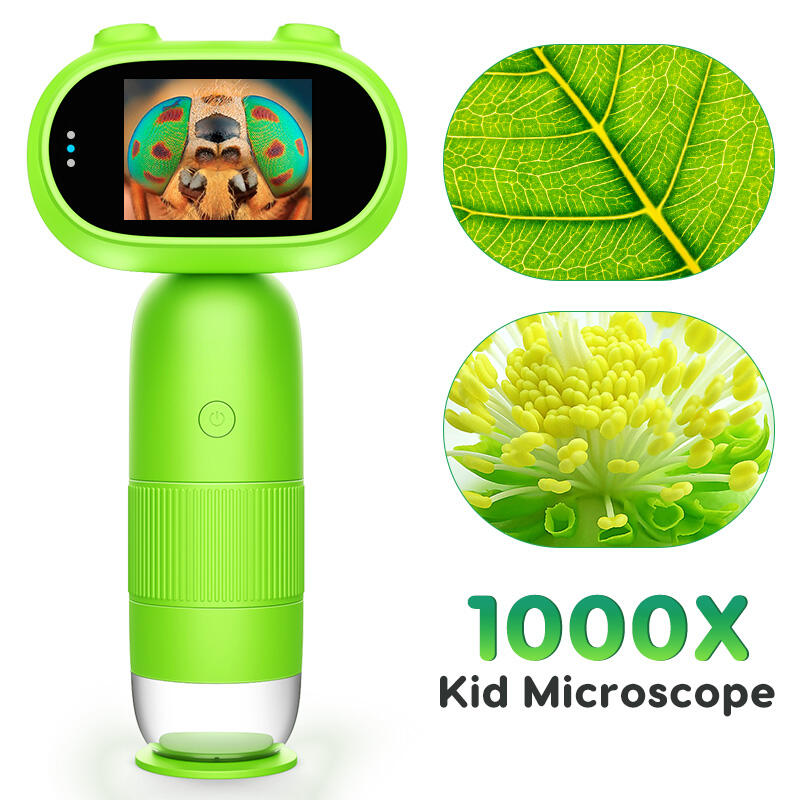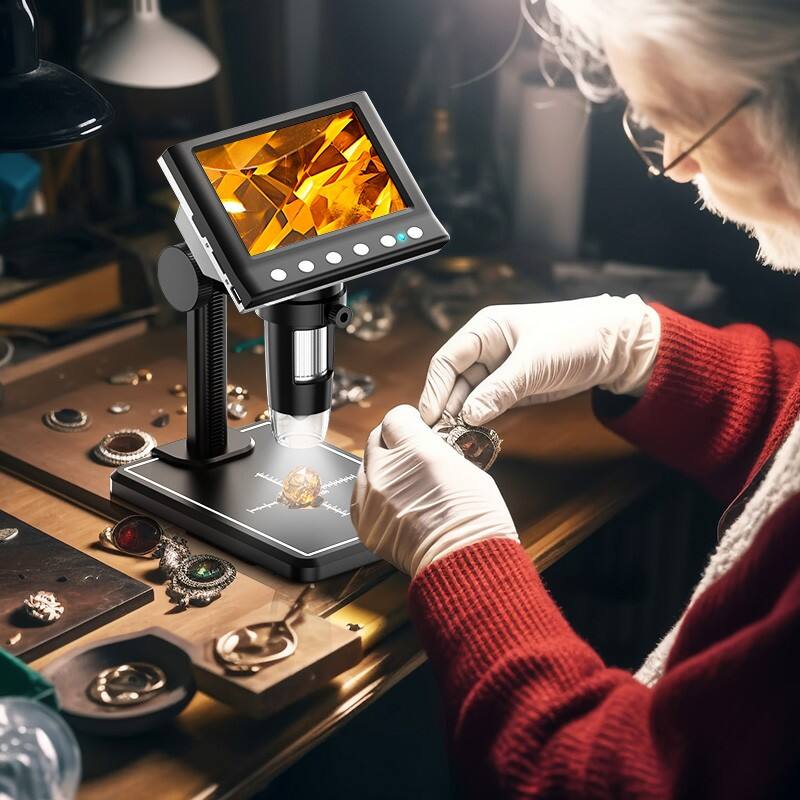Field research has been revolutionized by the advent of modern portable microscopy technology. Scientists, researchers, and field workers now have unprecedented access to microscopic examination capabilities while conducting studies in remote locations. A portable microscope serves as an essential tool that bridges the gap between laboratory-grade analysis and on-site investigation requirements. These compact instruments enable real-time specimen examination, immediate data collection, and preliminary analysis without the need to transport samples back to traditional laboratory settings.

Understanding Portable Microscope Technology
Digital Enhancement Features
Modern portable microscopes incorporate advanced digital imaging technology that significantly enhances field research capabilities. These devices typically feature high-resolution cameras with magnification ranges extending from 50x to 1000x or higher, providing researchers with detailed visualization of microscopic structures. The integration of LCD screens eliminates the need for eyepiece viewing, reducing eye strain during extended observation periods while enabling multiple researchers to view specimens simultaneously.
Digital capture functionality allows researchers to document findings immediately, creating a comprehensive visual record of field observations. Many portable microscopes include built-in storage capabilities or connectivity options that enable direct transfer of images and videos to computers or mobile devices. This feature proves invaluable for creating detailed field reports, sharing findings with colleagues in real-time, and maintaining accurate documentation for later analysis.
Power Management Systems
Battery life represents a critical consideration for field research applications, where access to power sources may be limited or unavailable. High-quality portable microscopes incorporate efficient LED illumination systems that provide excellent specimen visibility while minimizing power consumption. Rechargeable lithium-ion batteries typically offer several hours of continuous operation, with some models providing extended battery life through optimized power management systems.
USB charging capabilities ensure compatibility with various power sources, including portable battery packs, solar chargers, and vehicle power outlets. Some advanced models feature dual power options, allowing operation through both internal batteries and external power sources, providing flexibility for extended field studies and continuous monitoring applications.
Essential Field Research Applications
Environmental Sample Analysis
Environmental researchers utilize portable microscopes for immediate assessment of water quality, soil composition, and biological specimens encountered during field studies. Water samples can be examined for microorganisms, algae, and contaminants without the delay associated with laboratory transport and processing. This real-time analysis capability enables researchers to make informed decisions about sampling locations, identify areas of concern, and adjust research protocols based on immediate findings.
Soil analysis benefits significantly from portable microscopy, allowing researchers to examine soil structure, identify organic matter content, and assess microbial activity directly in the field. Plant tissue examination enables immediate identification of diseases, pest damage, and cellular structures that may influence research outcomes. The ability to document these findings with integrated cameras creates a comprehensive field record that supports detailed analysis and report generation.
Geological and Material Science Applications
Geological field work often requires immediate examination of rock samples, mineral compositions, and crystalline structures that cannot be adequately assessed through visual inspection alone. A portable microscope enables geologists to identify mineral components, assess grain size distributions, and examine surface textures that provide crucial information about formation processes and geological history. This immediate analysis capability helps researchers make informed decisions about sample collection priorities and field study directions.
Material science applications extend to examining manufactured components, investigating failure mechanisms, and assessing surface treatments in field conditions. Construction materials, protective coatings, and composite structures can be evaluated for quality control purposes, with findings documented through integrated imaging systems for immediate reporting to project stakeholders.
Optimization Strategies for Field Use
Specimen Preparation Techniques
Effective specimen preparation in field conditions requires adaptation of traditional laboratory techniques to accommodate limited resources and environmental constraints. Portable preparation kits should include basic cleaning supplies, mounting media, and simple staining solutions that remain stable under varying temperature and humidity conditions. Pre-prepared slide sets can serve as reference materials for comparison purposes and quality control verification.
Water-based mounting media typically provides adequate results for most field applications while avoiding the hazards associated with organic solvents in outdoor environments. Simple cleaning protocols using distilled water or mild detergent solutions can effectively prepare specimens for examination without requiring specialized laboratory equipment or controlled environmental conditions.
Environmental Adaptation Methods
Field conditions present unique challenges that require careful consideration of environmental factors affecting portable microscope performance. Temperature variations can impact focus stability and image quality, necessitating acclimatization periods when moving equipment between different environmental conditions. Protective cases and weather-resistant designs help maintain equipment integrity during transport and operation in challenging field conditions.
Dust and moisture protection becomes essential for maintaining optical clarity and electronic functionality. Regular cleaning protocols using appropriate lens cleaning materials help preserve image quality throughout extended field studies. Desiccant packs stored within equipment cases can help control moisture levels and prevent condensation formation on optical surfaces.
Data Management and Documentation
Image Capture Optimization
Effective image capture requires understanding the relationship between magnification levels, lighting conditions, and specimen characteristics to achieve optimal documentation results. Proper illumination adjustment ensures adequate contrast and detail visibility while avoiding overexposure that can obscure important features. Multiple magnification levels of the same specimen provide comprehensive documentation that supports detailed analysis and peer review processes.
Standardized naming conventions and metadata recording help maintain organized documentation systems that facilitate later analysis and report generation. GPS coordinates, collection times, and environmental conditions should be recorded alongside microscopic images to provide complete context for research findings. This comprehensive documentation approach ensures research integrity and supports reproducible scientific methodologies.
Integration with Research Workflows
Successful integration of portable microscopy into research workflows requires careful planning of data collection protocols, storage systems, and analysis procedures. Cloud-based storage solutions enable immediate backup of field data and facilitate collaboration among research team members located in different geographical areas. Standardized file formats ensure compatibility with laboratory analysis software and maintain data accessibility across different computing platforms.
Regular data synchronization protocols help prevent data loss and ensure that field observations are immediately available to support decision-making processes. Integration with laboratory information management systems enables seamless transition between field observations and detailed laboratory analysis, creating comprehensive research datasets that support robust scientific conclusions.
Maintenance and Troubleshooting
Preventive Care Protocols
Regular maintenance protocols help ensure reliable portable microscope performance throughout extended field research periods. Daily cleaning routines should include gentle removal of dust and debris from optical surfaces using appropriate cleaning materials and techniques. Lens cleaning solutions specifically formulated for optical instruments help maintain clarity without damaging delicate coatings or surfaces.
Battery maintenance involves regular charging cycles and proper storage procedures that maximize battery life and performance reliability. Firmware updates should be installed prior to field deployment to ensure access to the latest features and performance improvements. Calibration verification using known standards helps maintain measurement accuracy and ensures consistent results across different operating conditions.
Field Repair Strategies
Basic troubleshooting knowledge enables researchers to address common operational issues without requiring specialized technical support or equipment replacement. Understanding proper handling techniques helps prevent damage during transport and operation, while knowledge of basic adjustment procedures enables optimization of performance for specific research requirements.
Emergency repair kits should include essential spare parts such as batteries, cleaning supplies, and protective covers that address the most common failure modes encountered during field operations. Contact information for technical support services and authorized repair facilities should be readily available to address more complex issues that cannot be resolved through basic troubleshooting procedures.
FAQ
What magnification range is most suitable for general field research applications?
For most field research applications, a magnification range between 100x and 800x provides optimal versatility for examining various specimen types. This range enables detailed observation of cellular structures, microorganisms, and material surfaces while maintaining sufficient field of view for specimen location and navigation. Higher magnifications may be beneficial for specialized applications but often require more precise focusing and stabilization that can be challenging in field conditions.
How do I maintain image quality in challenging weather conditions?
Maintaining image quality in adverse weather requires protection of optical surfaces from moisture, dust, and temperature fluctuations. Use protective covers when not actively observing specimens, allow equipment to acclimatize to temperature changes gradually, and clean optical surfaces regularly with appropriate materials. Consider using UV filters or protective lenses in dusty environments, and store equipment in sealed containers with desiccant packs when not in use.
What backup power options work best for extended field studies?
Extended field studies benefit from multiple backup power options including high-capacity power banks, solar charging panels, and vehicle charging adapters. Lithium-ion power banks with capacities exceeding 20,000mAh can provide several days of operation for most portable microscopes. Solar panels with battery storage capabilities offer sustainable power generation for remote locations, while 12V vehicle adapters enable charging during transportation between study sites.
How should I organize and store field data for maximum research value?
Organize field data using consistent naming conventions that include date, time, location, and specimen information. Create hierarchical folder structures that separate different study sites, specimen types, and collection dates. Include metadata files with detailed information about collection conditions, equipment settings, and preliminary observations. Regular backup to cloud storage services ensures data security and enables remote access for collaborative analysis and report generation.

